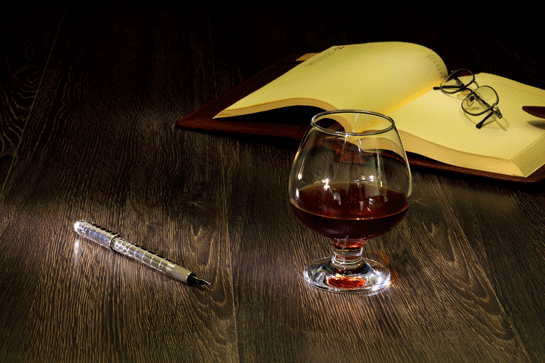Wine in Literature
A literary and oenology IQ quiz
Richard L. Elia

Wine is universal, and nowhere more evident than in literature. In the Old Testament, Noah had a vineyard and got himself intoxicated. Homer often referenced wine and his “wine dark sea” is now a stock phrase. Horace loved wine giving him “wit and love,” and offered to his “desperate mind the balm of hope.” Chaucer had his “mead” (honey wine with spices), and his Canterbury Prioress drank her “draught of wine.” Since the 12th century, the English have been drinking Bordeaux wines (Claret to the Brits, from caliret, meaning dark rosé) so allusions are expected. In France, Rabelais sang the praises of Loire wine.
In literature, the English are fond of referencing wine. War had much to do with this. Sir Francis Drake attacked the port of Cadiz, set back the Spanish Armada, and returned with 2,900 butts (casks) of Sherry, consequently introducing it to Shakespeare’s Falstaff who advised us to “addict [ourselves] to sack (Sherry).”
It wasn’t, however, until the 18th and 19th centuries that wine started to gain a firmer literary frame of reference especially in the novel, which was emerging as a new genre. The Treaty of Methuen in the early 18th century introduced Port to England which became the beverage of choice among the upper classes and novelists. Wine’s popularity among writers began to grow. Henry Fielding’s swashbuckling novel, Tom Jones, has his eponymous hero inspired by “syllabub,” a wine mixed with cider. Jane Austen’s “venial error” was to tipple a few too many at “Hurstbourne,” and Mrs. Jennings in Sense and Sensibility recommends Constantia wine for its “healing powers on a disappointed heart.” Thackeray spent much of his life at wine parties and drinking at his club.
Two factors are chief influences of wine’s popularity in late 19th century England: the state of the water, and the prominence of Oxford University. Water pollution was an ancient issue, and alcohol became the beverage of choice because of it. In 1858, water contamination caused the cholera epidemic. Improper sewerage was the culprit, and alcohol became safer than water. During the latter decades of the Victorian era, Oxford’s many colleges, which made up the University, were creating wine cellars. Every spire had its collection of fine wines, chief among them, of course, were Sherry, Port, and Bordeaux. Further, dozens of wine shops began to dot the Oxford area and their merchants were eager to advise the colleges. Author and professor of classics Walter Pater was among the admirers, writing often of Tuscan wine and its vineyards. His incomparable admirer, Oscar Wilde, loved all wine, especially Champagne, and on his deathbed, as legend has it, ordered Champagne, sighing “Alas, I am dying beyond my means.”
University wining and dining evenings, along with wine etiquette, became popular. Fifty years later the dreamy spires of Oxford graduated many admirers (Serena Sutcliffe, Jancis Robinson and others) who became Masters of Wine, an Institute that started in 1953. And, as if to punctuate the importance of Oxford and to add prestige to the publication, one of the major wine books of oenology is The Oxford Companion to Wine edited by Jancis Robinson.
Writers of the last fifty years make less of wine than Evelyn Waugh did. References are made, of course, but the passion and poetry about wine is absent. Few today would write of Burgundy what Waugh did in Brideshead Revisited: an older Burgundy is brought out and Charles Ryder, the main character, says, “[the Burgundy] seemed to me, then, serene and triumphant, a reminder that the world was an older and better place . . .”
